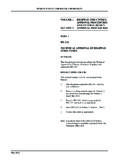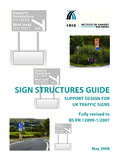Transcription of Eurocode 7 is coming
1 Eurocode 7 is coming Dr Andrew Bond (Geocentrix). Outline of talk z The Structural Eurocodes programme z The new principles of Eurocode 7. z The bigger picture z Impact of Eurocode 7. This presentation is available from: 1. References 1. National Strategy for implementation of the Structural Eurocodes: Design Guidance, IStructE (April 2004). Nethercott et al., IStructE. 2. PP 1990: 2004. Guide to the Structural Eurocodes for students of structural design Bright et al. ( 7 by Bond and Harris), BSI. 3. EC7 implications for UK practice (in preparation). Driscoll, Powell, et al., CIRIA Report RP701. Eurocode 7 is coming The Structural Eurocodes programme 2. What are the Eurocodes? z The structural Eurocodes are a European suite of codes for structural design . developed over twenty-five years1. z By 2010 they will have effectively replaced the current British Standards as the primary basis for designing buildings and civil engineering structures in the UK.
2 Z They [will be] used as an acceptable basis for meeting compliance with UK Building Regulations and the requirements of other public authorities Structural Eurocodes programme composite steel and EN 1994: Design of concrete structures aluminium structures EN 1999: Design of 3. Eurocode 7 is coming is here! z Prospective standards for provisional application (ENVs). z ENV 1997-1: 1994. z ENV 1997-2: 1999. z ENV 1997-3: 1999. z Full European standards (ENs). z EN 1997-1 published December 2004. z prEN 1997-2 available, EN 1997-2 to be published anytime soon Timetable for introduction Final text of Eurocode Part 2005 released to BSI by CEN. Prepare National Modify regulations to 2006 Annex allow use of Eurocode BSI publishes Part with 2007 National Annex 2008. Co-existence period with British Standards 2009. Withdrawal of British Standards having same scope as Eurocode 2010. 4. Contents of EN1997-1 General rules Contents of prEN 1997-2.
3 Design assisted by field and laboratory testing 5. Eurocode 7 is coming is here! The new principles of Eurocode 7. Principles and Application Rules z Principles z General statements and definitions for which there is no alternative z Requirements and analytical models for which no alternative is permitted unless specifically stated z Principles are preceded by the letter (P). z Verb used is shall . z Application Rules z Examples of generally recognised rules, which follow the Principles and satisfy their requirements z Verbs used are should , may , can , etc. 6. Design requirements z (1)P For each geotechnical design situation it shall be verified that no relevant limit state is exceeded z (4) Limit states should be verified by z Use of calculations z Adoption of prescriptive measures z Experimental models and load tests z An observational method Complexity of design z (8)P The complexity of each geotechnical design shall be identified together with associated risks a distinction shall be made between: z light and simple structures and small earthworks with negligible risk*.
4 Z other geotechnical structures z *May be designed on basis of past experience and qualitative geotechnical investigations 7. Geotechnical categories GC Includes Design requirements Design procedure 1 Small and Negligible risk of Routine design &. relatively small instability or ground construction methods structures with movements negligible risk Ground conditions known No excavation below water table 2 Conventional Quantitative geotechnical Routine field & lab types of structure data & analysis to ensure testing & foundation fundamental Routine design &. with no requirements are satisfied execution exceptional risk or difficult soil or loading conditions 3 Structures or Use alternative provisions and rules to those in parts of Eurocode 7. structures not covered above Actions and effects (from EN 1990). z Action (F). z Direct action z Set of forces (loads) applied to the structure z Indirect action z Set of imposed deformations or imposed accelerations caused for example, by temperature changes, moisture variation, uneven settlement or earthquakes z Effect of action (E).
5 Z On structural members z internal force, moment, stress, strain z On the whole structure z deflection, rotation 8. Cause and effect z "For every action, there is an equal and opposite re-action". z Sir Isaac Newton, Principia Mathematica Philosophiae Naturalis (1686), third law of motion Duration of actions (from EN 1990). z Permanent action (G). z Likely to act throughout design situation z Variation with time is negligible and monotonic z Variable action (Q). z Unlikely to act throughout design situation z Variation with time is neither negligible nor monotonic z Accidental action (A). z Unlikely to occur with significant magnitude during design situation z Seismic action (AE). z Due to earthquake ground motions 9. Ultimate limit states for stability EQU UPL HYD. Loss of static equilibrium Uplift by water pressure Hydraulic heave/erosion Limit states EQU, UPL, and HYD. z Definition of limit state EQU.
6 Z Loss of equilibrium of the structure or the ground, considered as a rigid body, in which the strengths of structural materials and the ground are insignificant in providing resistance z Definition of limit state UPL. z Loss of equilibrium of the structure or the ground, due to uplift by water pressure (buoyancy) or other vertical actions z Definition of limit state HYD. z Hydraulic heave, internal erosion and piping in the ground caused by hydraulic gradients 10. Verification of stability for EQU. Destabilising effects of actions Stabilising effects of actions Resistance Characteristic Characteristic Characteristic destabilising stabilising material actions Fdst,k actions Fstb,k properties Xk Design Design Partial factors Design material Partial factors destabilising F stabilising M. properties Xd actions Fdst,d actions Fstb,d Geotechnical analysis Design effects Design effects Partial factors Design Partial factors of destabilising E of stabilising R.
7 Resistances Td actions Edst,d actions Estb,d Verification Edst,d Estb,d + Td Ultimate limit states for strength STR GEO. Internal failure of structure Failure of the ground 11. Limit states GEO and STR. z Definition of limit state GEO. z Failure or excessive deformation of the ground, in which the strength of soil or rock is significant in providing resistance z often critical to sizing structural elements in foundations or retaining structures z Definition of limit state STR. z Internal failure or excessive deformation of the structure or structural elements in which the strength of structural materials is significant in providing resistance z includes (for example) footings, piles, and basement walls Verification of strength for GEO/STR. 12. Design Approaches z (1)P The manner in which [GEO and STR. are applied] shall be determined using one of three Design Approaches z Design Approaches are ONLY relevant to limit states STR and GEO.
8 Z NOTE 1 Particular Design Approach to be used may be given in the National Annex z UK/Denmark prefer DA1. z Germany/France prefer DA2. z Some countries will allow a choice Partial factors on input parameters z Geometrical parameters z Add tolerance a z ad = anom + a z Actions z Multiply by partial factors for actions F. z Fd = F Frep = F Fk z Material properties z Divide by partial factors for material properties M. z X d = X k / M. 13. Partial factors on output parameters z Effects of actions z Multiply actions by F. z Ed = E(Fd, Xd, ad). z (or) multiply effects of actions by F. z Ed = E E(Frep, Xd, ad). z (but not both). z Resistance z Divide material properties by M. z Rd = R(Fd, Xd, ad). z (or) divide resistance by R. z Rd = R(Fd, Xk, ad) / R. z (or) both z Rd = R(Fd, Xd, ad) / R. Provision of safety2 in DAs 1-3. Structure Design Approach 1 2 3. Combination Combination 1 2. Axially loaded Actions Resistances Actions & Actions &.
9 Piles and resistances material anchors properties &. Other Material resistances structures properties Slopes Effects of Effects of actions & actions &. resistances material properties &. resistances 14. Design material properties Derived geotechnical parameters 15. Characteristic material properties Geotechnical Design Report z (1)P The assumptions, data, methods of calculation and results of the verification of safety and serviceability must be recorded in a Geotechnical Design Report z Level of detail depends on type of design z Single sheet may be sufficient 16. Contents of GDR. Geotechnical Design Report Assumptions Methods of calculation Codes & standards Design values of soil &. applied rock properties Data Results of verification Suitability of site Description of site and proposed construction &. surroundings acceptable risks Client Description of site Geotechnical design conditions calculations & drawings Cross-reference Description of proposed Foundation design construction, including recommendations actions Supervision, monitoring, & maintenance requirements Ground Investigation Plan of supervision &.
10 Report monitoring Maintenance requirements Extract Eurocode 7 is coming is here! The bigger picture 17. Geographical impact of Eurocodes Geotechnical standardization movement z Comit Europ en de Normalisation (CEN). z TC250: Structural Eurocodes z Eurocode 7 covered by SC7. z TC288: execution of special geotechnical works z TC342: laboratory and field testing standards z International Standards Organization (ISO). z TC182: geotechnical investigation and testing 18. Work of CEN TC288. z Execution of special geotechnical work(s). z Bored piles (BS EN 1536: 2000). z Diaphragm walls (BS EN 1538: 2000). z Displacement piles (BS EN 12699: 2001). z Ground anchors (BS EN 1537: 2000). z Grouting (BS EN 12715: 2000). z Jet grouting (BS EN 12716: 2001). z Sheet pile walls (BS EN 12063: 1999). z Standards currently in preparation z Micropiles (prEN 14199: 2001). z Soil nailing (prEN 14490: 2002). z Reinforced fill (prEN 14475: 2002).












